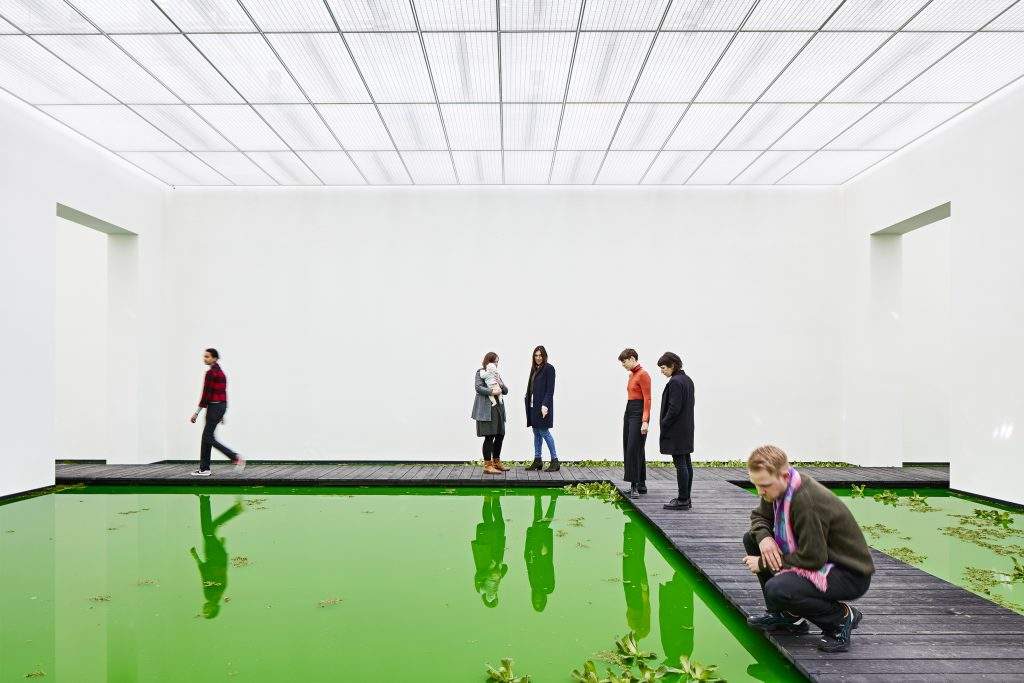Ã?lafur ElÃasson floods Basel's Fondation Beyeler to bring nature inside the museum
From April 18 to July 11, nature takes over the Fondation Beyeler in Basel: is the exhibition Life, an installation by Danish-Icelandic artist Ólafur Elíasson (Copenhagen, 1967), who has flooded the Swiss museum to recreate a natural environment in its spaces, invading them with water, plants and various microorganisms, and opening them up to outer space (in fact, Elíasson has also had the glass facade removed so that the interior communicates with the environment and opens its spaces to the action of the elements). The artist’s goal is to remove barriers between human beings and nature. Because nature can interact with the museum (potentially animals arriving from outside can take over the spaces, for example), the work is never the same and continues to transform throughout the duration of the exhibition (which, moreover, remains open day and night).
The exhibition intends to offer “human visitors” (so declares the artist) the opportunity to fully activate their sensory range: inside the exhibition they can smell plants and water, hear sounds, and feel the humidity of the air. On an aesthetic level, Elíasson also intends to provide a sculptural experience: the green water that occupies the exhibition space is soaked in uranine, a nontoxic dye used to trace water flows, deliberately employed by the artist to emphasize the presence of water. The plants featured (dwarf water lilies, Irish bellflowers, water ferns and many others) were chosen by landscape architect Günther Vogt.
“For the past few years,” declares Elíasson, "I have been striving more and more to consider life not from an anthropocentric perspective but according to a more broadly biocentric approach. I have found myself turning nouns into verbs (when I walk through my exhibition I try, for example, to tree) so as to capture perspectives that transcend what we humans are normally able to imagine. The lives of humans, as of all mammals, depend on inhaling and exhaling oxygen. In the wake of anthropologists Natasha Myers and Timothy Choy, I would be inclined to say that life is also co-breathing, playing with the etymology of the word (’breathing with’) and based on the definition given by vocabularies. We conspire with the tree, with each other and with the planet."
"Life,“ the artist further points out, ”presents a model for a future landscape. It is hospitable. A couple of years ago when with Sam Keller, Director of Fondation Beyeler, we were first discussing the exhibition, I thought why not invite everyone to the event? Let’s invite the planet, plants and various species. Instead of simply opening a door, I decided to remove all the structural obstacles that stood between the inside and outside of the building, and I am very grateful to Fondation Beyeler and architect Renzo Piano, who built the museum, for allowing me to carefully and thoughtfully have the glass facade of the building removed."
“This work,” notes Sam Keller, director of the Fondation Beyeler, “is a collective experiment that challenges our conventions about art, nature, institutions and life in an attempt to dissolve the boundaries that separate them. Plants, animals, humans and microorganisms cohabit in this work. Time of day and weather concur to influence the course and perception of the exhibition. Nature and culture are united. Art and life come together. Ólafur Elíasson’s work unveils a free and thinking living space.”
Image: Olafur Eliasson, Life (2021). Installation view, Fondation Beyeler, Riehen/Basel (2021). Courtesy of the artist; neugerriemschneider, Berlin; Tanya Bonakdar Gallery, New York/Los Angeles. © 2021 Olafur Eliasson. Photo: Mark Niedermann.
 |
| Ólafur ElÃÂasson floods Basel's Fondation Beyeler to bring nature inside the museum |
Warning: the translation into English of the original Italian article was created using automatic tools. We undertake to review all articles, but we do not guarantee the total absence of inaccuracies in the translation due to the program. You can find the original by clicking on the ITA button. If you find any mistake,please contact us.





























